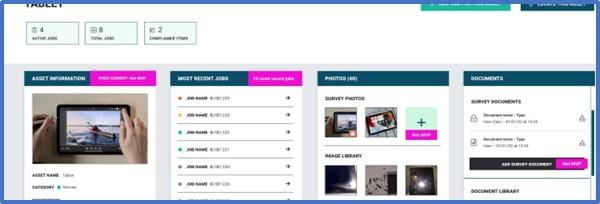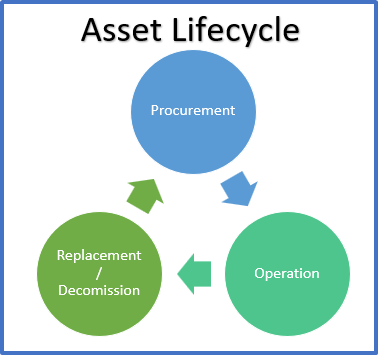This Blog has been written through the eyes of the author and we welcome comments and suggestions if you feel any information is wrong, misleading or missing. I hope to provide a research tool for those wishing to learn more about the subject of Asset Management.
In this blog I will aim to clarify a couple of points:

I guess it’s best to kick things off with this blog’s name sake.
In my time managing buildings, facilities departments, sites and estates, it’s become very apparent that nearly everyone seems to have their own (and occasionally somewhat very unique) interpretation on what constitutes as ‘Asset Management’.
It’s important to note here, that during my research I noticed IT Asset Management and Financial Asset Management appear to hog the limelight on this subject. If you are here to learn more about those, then Google is your friend. This blog is specifically about Asset Management in the built environment (ie: fixed and moveable assets such as an air conditioning unit or an office chair and so on).
To one person Asset Management is the act of keeping a vague list of ‘things’ in one’s head that need to be serviced and looked after (possibly could be entered onto a spreadsheet… who knows), to the next person, it’s the act of importing a carefully manicured list of assets into an ‘enterprise level EAM software’ with all the bells whistles and jargon, tended to by a team of highly qualified individuals.
Hopefully, the outcome is that in some way an asset is being tracked through three core stages, more colloquially known as the Asset Lifecycle.
Stage 1) Asset Procurement
Stage 2) Asset Operation
Stage 3) Asset Decommissioning and/or Replacement
If all three stages are tracked and managed it should provide interested parties with a ‘cradle to grave’ overview of any given asset’s history.
This is ‘cradle to grave’ style overview is important because when the Asset Lifecycle is being tracked properly, it supplies the business with key information on resource requirements and predictable budget requirements while also helping the business to spot trends.
A somewhat important question, and equally important thing to define considering the reason for this Blog.
The easy route out here is to say… An asset is pretty much whatever your organisation interprets as an asset. Not unreasonably, this isn’t too far from the truth.
Assets appear to fall into two key categories:
1) Fixed Assets
2) Mobile/Movable Assets
Take a ceiling mounted air-conditioning unit. I hope you’ll agree we could safely class that as a fixed asset. What about the earlier mentioned office chair, safe to assume a mobile asset?
Both assets will have different levels of importance and management requirements.

For example, you might wish to track the office chair with sensors and ‘IOT’ integrated into your Asset Management software. This will help the organisation to understand staff movement and occupancy levels of spaces around your buildings.
Whereas, the air-conditioning unit isn’t going anywhere so tracking isn’t important, however, if it goes wrong, you’ll end up with a lot of unhappy staff on that warm summer’s day (not to mention a big repair bill) so it is vitally important every facet of its maintenance program is kept up to date and you know who did what and when.
There are of course an infinitely huge number of assets that might fall under the remit of Asset Management. Not necessarily all fall into traditional categorisations. These can be things such as vehicles, certifications, landscaping elements and so on.
An asset is very much defined by the organisation and by the individuals responsible.
We touched on this earlier, but let’s dive into the subject in a bit more detail.
We already know Assets follow a cradle to grave cycle called the ‘Asset Lifecycle’.

Let’s look at each stage:
Stage 1 – Asset Procurement.
Asset Procurement, the point at which the Asset Lifecycle begins. This stage can be further broken down into Planning and Purchasing stages.
Planning might involve consulting existing data from your Asset Management system, consulting with Staff and Maintenance engineers. You may choose to look at industry peers for best practice, and research new technologies.
You may of course also choose to employ consultants to act as subject matter experts to advise on a best course of action.
You may also factor in budgetary constraints, such as unit price and ongoing maintenance costs. Needless to say, environmental credentials will inevitably play a part.
Inevitably a choice will be made, and the Asset will be purchased.
Stage 2 – Asset Operation.
Arguably the meaty bit of the process. This stage can last for months, though usually years, in some cases even decades. It is vitally important Stage 1 is carried out properly to ensure you don’t pay the price for a bad decision during the operation of the asset.
During this stage, a number of resources could be employed from physical manpower to specialist Asset Management systems.
In larger organisations, with the appropriate resources available, it is likely to be a comprehensive use of both, while in smaller organisations there may tend to be a compromise.
From what I can see and have learned learnt, its important organisations balance both the use of Manpower and the use of Asset Management systems in fairly equal measure during this phase of the Asset Lifecycle.
Having the manpower to maintain the assets is great. It can, however, become extremely costly if the information produced by the engineers and specialists on the asset’s day to day operation is not sensibly stored and made available for future interrogation.
Likewise, a great Asset Management system is nothing without good information and data to populate it So, a balance must be struck.
During the operational phase of an Assets lifecycle, it is important data is monitored, and trends are analysed. Vigilant Asset Managers will be able to act on the data to prevent costly mistakes and prepare the business for future investment requirements.
Stage 3 – Decommission and/or Replacement
Inevitably an asset will reach the end of its operational life and need to be removed or replaced.
If stage 2 has been carried out well, the business should have access to good information on whether an asset can simply be decommissioned or whether it needs to be replaced.
If the intention is not to replace, and to only remove the now dead asset, a process must be followed, legislation observed and records kept. Its vitally important this information is preserved for future use.
In my personal experience, its sadly the case that decommissioning information and records are rarely kept and maintained. The reason for its removal lost and the costs forgotten.
This information can have a number of uses, I have found it to be particularly important when carrying out audits. I heard the term recently ‘Ghost Assets’ and boy have I had a few of those in the past.
For those that don’t know, a Ghost Asset is an asset that appears to be very much live and inevitably racking up maintenance costs, when in fact it’s no longer physically there (or at least no longer being used). A prime reason Decommissioning and Replacement data is so important. Ghost assets can cost significant sums of money over a period of years.
A quick google search will yield a bewildering array of systems and processes one can follow. Not being a person who likes too much choice, I have categorised the options below:
My research has led me to believe, large organisations will tend to employ systems such as Salesforce or Maximo to name a couple, for a separate reason (likely CRM or Workflow Management of some form) and have a bolt-on module to support Asset Management requirements.
This tends to create a situation of compromise where working practices must compromise to fit the product capabilities and sadly sometimes fall short in their offering due to their non-specialist nature.
Research has demonstrated a staggering array of options available on the market. From what I can tell, they fall broadly into two sub-categories, those with ‘IoT’ capability and those without.
Systems without ‘IoT’, tend to allow the use of Barcode and QR code scanning, combined with some degree of automation, notification, possibly trend analysis etc.
These systems can really begin to add significant value to the whole Asset Management process, however, we can step up the system capabilities quite significantly by introducing ‘IoT’ into the mix…
Employing ‘IoT’ is when Asset Management can really start to get interesting.
What on earth is IOT anyway? oracle.com has a lovely definition:
‘’The Internet of Things (IoT) describes the network of physical objects—“things”—that are embedded with sensors, software, and other technologies for the purpose of connecting and exchanging data with other devices and systems over the internet.’’
The use of sensors and trackers can add a whole new dimension to Asset Management. It takes an otherwise still manpower-intensive, passive process, and turns it into a live, active, data-rich resource where anything is made possible.
Traditionally, this would fall to an Asset Manager or Facilities Manager, but in truth the answer is anyone and everyone.
Your organisation may have strict rules about who does or doesn’t manage assets, even so, the people interacting with an asset still play a part and should not be ignored.
User habits can have a huge effect on the lifecycle of an asset.
For example, it may be the sole responsibility within your organisation for the Asset Manager to look after the air conditioning units. They do that job well, employ a great Asset Management system and have highly skilled engineers maintaining the kit.
However, have they factored in that staff are having a big effect on the assets they so lovingly manage on their behalf.
Let’s suppose… Staff member A is always hot, so puts the air con unit on full cooling. Staff member B is always cold, so as soon as the aircon unit is put on full cooling, they change it to full heating. Throughout the day, and every day this cycle occurs, 8hrs a day, 5 days a week…
Two things to consider here, one is the staff and their needs. Secondly is the ‘Asset Manager’ and their responsibility.
In my time as a Facilities Manager this example almost became a running joke but is based on some degree of fact (ask any FM!).
Considered employment of a Good Asset Management system, Staff training and awareness on effective ways to use the assets at their disposal, a good maintenance regime and constant review of data would have an extremely positive and cost-effective effect on the asset lifecycle.
So, who manages assets, everyone.
I get asked this a lot. What accreditations can I get if I use an Asset Management system?
I can only speak from the perspective of a reader within the United Kingdom, but it may apply elsewhere.
So far as I can tell, Asset Management is covered by three standards:
It’s worth noting, the above ISO standards have superseded the older PAS 55 standards
The British Standards Institution (BSI) website (www.bsigroup.com) provides all the information required.
We’ll cover the Accreditations in later blogs, the intention here is to provide awareness they exist.

I hope you have found this Blog useful. I appreciate it’s not a cover all but, in the least, should provide a broad overview on the subject.
Thank you for reading
Aran
AGS – Director
Share this post: